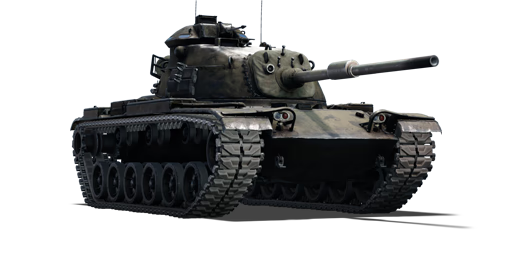

Ground Vehicles
M60
V
Rank
AB
8.0
RB
8.0
SB
8.0
Battle rating
USA
Game nation
Medium tank
Main role
120,000

Research
340,000

Purchase
General information
Survivability and armour
Armour
front / side / back
Hull
93 / 70 / 40 mm
Turret
130 / 76 / 51 mm
Visibility
141 %
Crew
4 persons
Support systems
Mobility
Max speed
Forward
4853 km/h
Backward
89 km/h
Power-to-weight ratio
16.214.43125.2 hp/t
Engine power
7506631,4311,162 hp
Weight
46.2 t
Optics
Gunner
Commander
Driver
Optics zoom
7.4x–8.0x
1.0x–7.0x
—
Optical device
Armaments
105 mm M68 cannon
Ammunition
57 rounds
First-order
22 rounds
Reload
basic crew → aces
8.7 → 6.7 s
Vertical guidance
-9 / 19°
Turret Rotation Speed
basic crew → aces
Horizontal
16.814.331.622.8 → 2420.445.232.6 °/s
Vertical
2.82.29.86.3 → 43.2149 °/s
| Ammunition | Type | Armor penetration (mm) at a distance: | |||||
|---|---|---|---|---|---|---|---|
| 10 m | 100 m | 500 m | 1000 m | 1500 m | 2000 m | ||
| APDS | 350 | 347 | 333 | 317 | 302 | 287 | |
| HESH | 127 | 127 | 127 | 127 | 127 | 127 | |
| HEATFS | 400 | 400 | 400 | 400 | 400 | 400 | |
| Smoke | 3 | 3 | 3 | 3 | 3 | 3 | |
12.7 mm M85 machine gun
Ammunition
900 rounds
Belt capacity
180 rounds
Reload
basic crew → aces
10.4 → 8 s
Fire rate
625 shots/min
Vertical guidance
-15 / 60°
Turret Rotation Speed
basic crew → aces
Horizontal
16.814.331.622.8 → 2420.445.232.6 °/s
Vertical
10.58.436.723.5 → 151252.533.6 °/s
| Belt | Belt filling | Armor penetration (mm) at a distance: | |||||
|---|---|---|---|---|---|---|---|
| 10 m | 100 m | 500 m | 1000 m | 1500 m | 2000 m | ||
| AP-I/AP-I/AP-I/AP-I/API-T | 28 | 26 | 18 | 11 | 7 | 4 | |
7.62 mm M73 machine gun (coaxial)
Ammunition
6,000 rounds
Belt capacity
250 rounds
Reload
basic crew → aces
10.4 → 8 s
Fire rate
500 shots/min
| Belt | Belt filling | Armor penetration (mm) at a distance: | |||||
|---|---|---|---|---|---|---|---|
| 10 m | 100 m | 500 m | 1000 m | 1500 m | 2000 m | ||
| AP/T | 13 | 12 | 7 | 3 | 2 | 0 | |
Economy
Repair cost
Basic → Reference
AB
4,403 → 5,768 

RB
4,905 → 6,426 

SB
6,955 → 9,111 

Crew training
98,000 

Experts
340,000 

Aces
1,300 

Research Aces
780,000 

Reward multiplier
AB / RB / SB
140 / 200 / 240 % 

202 % 

Total cost of modifications
98,000 

165,000 

Talisman cost
2,200 

Research order:
Mobility | |
|---|---|
Protection |
|---|
Firepower | ||
|---|---|---|
Rating by players
You must play more than 3 battles for the last week and more than 10 battles in a vehicle to rate it.
Like:
44
Armor protection:
Not enough ratings
Survivability:
Not enough ratings
Mobility:
Not enough ratings
Armament:
Not enough ratings
Balance:
Not enough ratings
Tips & Tricks
This space is currently empty
Do you know any interesting vehicle features?
Loading...
No articles about this vehicle yet
Become the first author and get rewards!
Write a guide, tell about interesting historical facts, make a tutorial or simply an interesting post.
No more content